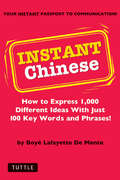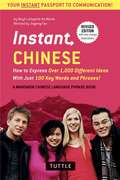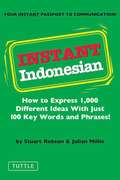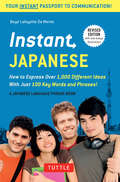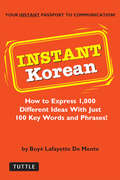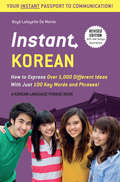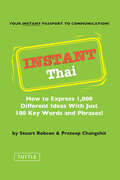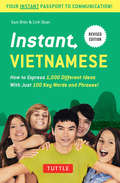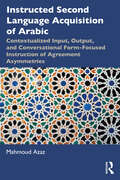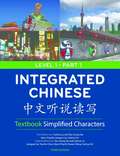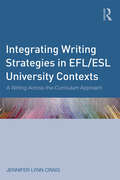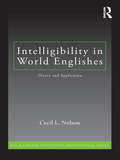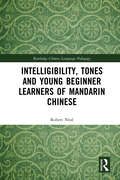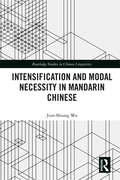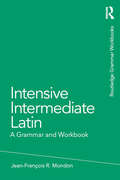- Table View
- List View
Instant Chinese
by Boyé Lafayette De MenteIt's amazing how 100 key words and phrases provide instant communication!Do you want to speak simple Mandarin Chinese but are too busy to study it? Are you visiting China for a short time and want a Mandarin phrase book to help you communicate in the Chinese Language? If so, this is the book for you. It includes all the essential content necessary to speak basic Mandarin.The idea of Instant Chinese is simple-learn 100 words and phrases and say 1,000 things. The trick is knowing which 100 words to learn, but the author Boye Lafayette De Mente has solved the problem, choosing only those words you'll hear again and again. Even with a vocabulary this small, you'll be surprised how quickly and fluently you too can communicate in Mandarin Chinese. Words are repeated in different combinations, building familiarity without effort. All phrases are given in both simplified Chinese characters and standard Hanoi Pinyin romanization. A brief guide to pronunciation allows the user to say the phrases correctly. Here's a sample of what you'll be able to do:Meet peopleGo shoppingAsk directionsRide the subwayOrder food and drinksAnd much more
Instant Chinese: How to Express Over 1,000 Different Ideas with Just 100 Key Words and Phrases! (A Mandarin Chinese Language Phrasebook
by Boye Lafayette De Mente Jiageng FanIt's amazing how 100 key words and phrases provide instant communication!Do you want to speak simple Mandarin Chinese but are too busy to study it? Are you visiting China for a short time and want a Mandarin phrase book to help you communicate in the Chinese language? If so, this Mandarin phrasebook is for you. It's tiny 0.4 x 4.1 x 5.9 inches size makes it incredibly convenient to travel with but without losing the most essential content for communication. This new, expanded edition contains 15% more content, fun manga-style illustrations, and additional information on which destinations, personalities and trends are hot in China right now!The idea of Instant Chinese is simple--learn 100 words and phrases and say 1,000 things. The trick is knowing which 100 words to learn, but the author Boye Lafayette De Mente has solved the problem, choosing only those words you'll hear again and again. Even with a vocabulary this small, you'll be surprised how quickly and fluently you too can communicate in Mandarin Chinese. Words are repeated in different combinations, building familiarity without effort. All phrases are given in both simplified Chinese characters and standard Hanoi Pinyin romanization. A brief guide to pronunciation allows the user to say the phrases correctly. An English-Chinese glossary makes looking up a word or phrase simple and quick. Here's a sample of what you'll be able to do with this chinese phasebook: Meet people. Go shopping. Ask directions. Ride the subway. Order food and drinks. And much more.
Instant Indonesian
by Stuart Robson Julian MillieIt's amazing how 100 key words and phrases provide instant communication!Do you want to speak simple Indonesian but are too busy to study it? Are you visiting Indonesia for a short time and want an Indonesian phrase book to help you communicate? If so, this is the book for you. It includes all the essential content necessary to speak basic Indonesian.The idea of Instant Indonesian is simple-learn 100 words and phrases and say 1,000 things. The trick is knowing which 100 words to learn, but the authors Stuart Robson and Julian Millie have solved the problem, choosing only those words you'll hear again and again. Even with a vocabulary this small, you'll be surprised how quickly and fluently you too can communicate in Indonesian. Words are repeated in different combinations, building familiarity without effort. A brief guide to pronunciation allows the user to say the phrases correctly. Here's a sample of what you'll be able to do:Meet peopleGo shoppingAsk directionsRide the subwayOrder food and drinksAnd much more
Instant Indonesian
by Stuart Robson Julian MillieIt's amazing how 100 key words and phrases provide instant communication!Do you want to speak simple Indonesian but are too busy to study it? Are you visiting Indonesia for a short time and want an Indonesian phrase book to help you communicate? If so, this is the book for you. It includes all the essential content necessary to speak basic Indonesian.The idea of Instant Indonesian is simple-learn 100 words and phrases and say 1,000 things. The trick is knowing which 100 words to learn, but the authors Stuart Robson and Julian Millie have solved the problem, choosing only those words you'll hear again and again. Even with a vocabulary this small, you'll be surprised how quickly and fluently you too can communicate in Indonesian. Words are repeated in different combinations, building familiarity without effort. A brief guide to pronunciation allows the user to say the phrases correctly. Here's a sample of what you'll be able to do:Meet peopleGo shoppingAsk directionsRide the subwayOrder food and drinksAnd much more
Instant Japanese
by Boye Lafayette De MenteIt's amazing how 100 key words and phrases provide instant communication!Do you want to speak simple Japanese but are too busy to study it? Are you visiting Japan for a short time and want an Japanese phrase book to help you communicate? If so, than this thoroughly revised second edition of Boye Lafayette De Mente's classic, bestselling phrase book is for you. It's tiny 0.4 x 4.1 x 5.9 inches size makes it incredibly convenient to travel with but without losing the most essential content for communication.The idea of Instant Japanese is simple--learn 100 words and phrases and say 1,000 things. The trick is knowing which 100 words to learn, but the author, De Mente has solved the problem, choosing only those words you'll hear again and again. Even with a vocabulary this small, you'll be surprised how quickly and fluently you too can communicate in Japanese. Words are repeated in different combinations, building familiarity without effort. A brief guide to pronunciation allows the user to say the phrases correctly. Here's a sample of what you'll be able to do with this Japanese phrasebook: Meet people. Go shopping. Ask directions. Ride the subway. Order food and drinks.
Instant Korean
by Boyé Lafayette De MenteIt's amazing how 100 key words and phrases provide instant communication!Do you want to speak simple Korean but are too busy to study it? Are you visiting Korea for a short time and want a Korean phrase book to help you communicate? If so, this Korean phrasebook for you. It includes all the necessary information to speak basic Korean.The idea of Instant Korean is simple--learn 100 words and phrases and say 1,000 things. The trick is knowing which 100 words to learn, but the author Boye Demente has solved the problem, choosing only those words you'll hear again and again. Even with a vocabulary this small, you'll be surprised how quickly and fluently you too can communicate in Korean. Here's a sample of what you'll be able to do with this Korean phrasebook:Meet peopleGo shoppingAsk directionsRide the subwayOrder food and drinksAnd much more
Instant Korean: How to Express Over 1,000 Different Ideas with Just 100 Key Words and Phrases!
by Boyé Lafayette De MenteThe idea of Instant Korean is simple—learn 100 words and phrases and say 1,000 things. The trick is knowing which 100 words to learn, but the author Boye Demente has solved the problem, choosing only those words you'll hear again and again. <P><P> Even with a Korean language vocabulary this small, you'll be surprised how quickly you can learn Korean and how fluently you too can communicate in Korean. An English–Korean glossary makes looking up words and phrases simple and quick. Here's a sample of what you'll be able to do with this Korean phrasebook: Meet people. Go shopping. Ask directions. Ride the subway. Order food and drinks. And much more.
Instant Thai
by Stuart Robson Prateep ChangchitIt's amazing how 100 key words and phrases provide instant communication!Do you want to speak simple Thai but are too busy to study it? Are you visiting Thailand for a short time and want a Thai phrase book to help you communicate? If so, this is the book for you. It includes all the necessary information to speak basic Thai.The idea of Instant Thai is simple-learn 100 words and phrases and say 1,000 things. The trick is knowing which 100 words to learn, but the authors Stuart Robson and Prateep Changchit have solved the problem, choosing only those words you'll hear again and again. Even with a vocabulary this small, you'll be surprised how quickly and fluently you too can communicate in Thai. It also has an English-Thai wordlist, arranged alphabetically. At the end of the book are useful appendices for telling the time, kinship terms, some Thai proverbs, and emergency expressions. Here's a sample of what you'll be able to do:Meet peopleGo shoppingAsk directionsRide the subwayOrder food and drinksAnd much more
Instant Thai: How to Express 1,000 Different Ideas with Just 100 Key Words and Phrases! (Thai Phrasebook)
by Stuart Robson Prateep ChangchitIt's amazing how 100 key words and phrases provide instant communication!Do you want to speak simple Thai but are too busy to study it? Are you visiting Thailand for a short time and want a Thai phrase book to help you communicate? If so, this is the book for you. It includes all the necessary information to speak basic Thai.The idea of Instant Thai is simple-learn 100 words and phrases and say 1,000 things. The trick is knowing which 100 words to learn, but the authors Stuart Robson and Prateep Changchit have solved the problem, choosing only those words you'll hear again and again. Even with a vocabulary this small, you'll be surprised how quickly and fluently you too can communicate in Thai. It also has an English-Thai wordlist, arranged alphabetically. At the end of the book are useful appendices for telling the time, kinship terms, some Thai proverbs, and emergency expressions. Here's a sample of what you'll be able to do:Meet peopleGo shoppingAsk directionsRide the subwayOrder food and drinksAnd much more
Instant Thai: How to Express 1,000 Different Ideas with Just 100 Key Words and Phrases! (Thai Phrasebook)
by Stuart Robson Prateep ChangchitIt's amazing how 100 key words and phrases provide instant communication!Do you want to speak simple Thai but are too busy to study it? Are you visiting Thailand for a short time and want a Thai phrase book to help you communicate? If so, this is the book for you. It includes all the necessary information to speak basic Thai.The idea of Instant Thai is simple-learn 100 words and phrases and say 1,000 things. The trick is knowing which 100 words to learn, but the authors Stuart Robson and Prateep Changchit have solved the problem, choosing only those words you'll hear again and again. Even with a vocabulary this small, you'll be surprised how quickly and fluently you too can communicate in Thai. It also has an English-Thai wordlist, arranged alphabetically. At the end of the book are useful appendices for telling the time, kinship terms, some Thai proverbs, and emergency expressions. Here's a sample of what you'll be able to do:Meet peopleGo shoppingAsk directionsRide the subwayOrder food and drinksAnd much more
Instant Vietnamese
by Linh Doan Sam BrierIt's amazing how 100 key words and phrases provide instant communication!Do you want to speak simple Vietnamese but are too busy to study it? Are you visiting Vietnam for a short time and want a Vietnamese phrase book to help you communicate? If so, this is the book for you. It includes all the necessary information to speak basic VietnameseThe idea of Instant Vietnamese is simple--learn 100 words and phrases and say 1,000 things. The trick is knowing which 100 words to learn, but the authors Sam Brier and Linh Doan have solved the problem, choosing only those words you'll hear again and again. Even with a vocabulary this small, you'll be surprised how quickly and fluently you too can communicate in Vietnamese. An added feature is an easy-to-use pronunciation guide that distinguishes between Northern Vietnamese (as spoken in Hanoi) and Southern Vietnamese (as spoken in Saigon), when the pronunciation is very different. Here's a sample of what you'll be able to do:Meet peopleGo shoppingAsk directionsRide the subwayOrder food and drinksAnd much more
Instant Vietnamese
by Linh Doan Sam BrierIt's amazing how 100 key words and phrases provide instant communication!Do you want to speak simple Vietnamese but are too busy to study it? Are you visiting Vietnam for a short time and want a Vietnamese phrase book to help you communicate? If so, this is the book for you. It includes all the necessary information to speak basic VietnameseThe idea of Instant Vietnamese is simple-learn 100 words and phrases and say 1,000 things. The trick is knowing which 100 words to learn, but the authors Sam Brier and Linh Doan have solved the problem, choosing only those words you'll hear again and again. Even with a vocabulary this small, you'll be surprised how quickly and fluently you too can communicate in Vietnamese. An added feature is an easy-to-use pronunciation guide that distinguishes between Northern Vietnamese (as spoken in Hanoi) and Southern Vietnamese (as spoken in Saigon), when the pronunciation is very different. Here's a sample of what you'll be able to do: Meet people, go shopping, ask directions, ride the subway, order food and drinks, and much more!
Instructed Second Language Acquisition of Arabic: Contextualized Input, Output, and Conversational Form-Focused Instruction of Agreement Asymmetries
by Mahmoud AzazInstructed Second Language Acquisition of Arabic examines the acquisition of agreement asymmetries in the grammatical system of Arabic as a second/foreign language through the lens of instructed second language acquisition. The book explores how to improve the processes of L2 learning of Arabic using evidence-based classroom research. Before it does this, it characterizes the variable challenges that English L2 learners of Arabic face when they acquire four structural cases in Arabic grammar that entail agreement asymmetries. Using the pretest–posttest design, it examines the effects of four classroom interventions using quantitative and qualitative measures. In these interventions, form-based and meaning-based measures were used to reveal to what degree learners have developed explicit and implicit knowledge of these aspects of asymmetry. In the concluding chapter, the book provides focused and specific implications based on the results of the four studies. It provides theoretical implications that enrich the discussions of instructed second language Acquisition in Arabic and other languages more broadly. It also provides implications for teachers, curriculum designers, and textbook writers of Arabic. This book will be informative for Arabic applied linguists, researchers of Arabic SLA, Arabic instructors (at the K–12 and the college level), and Arabic program directors and coordinators. The book will also appeal to all SLA and ISLA researchers.
Integrated Chinese 1: Simplified Characters
by Yuehua Liu Tao-Chung Yao Nyan-Ping Bi Liangyan Ge Yaohua ShiNIMAC-sourced textbook
Integrated Chinese 2: Simplified Characters
by Yuehua Liu Tao-Chung Yao Nyan-Ping Bi Liangyan Ge Yaohua ShiNIMAC-sourced textbook
Integrated Chinese 3 Textbook: Simplified and Traditional Characters
by Yuehua Liu Tao-Chung YaoNIMAC-sourced textbook
Integrated Chinese, Level 1, Part 1, Textbook: Zhong Wen Ting Shuo Du Xie
by Yuehua Liu Tao-Chung Yao Nyan-Ping Bi Liangyan Ge Yaohua ShiNIMAC-sourced textbook
Integrated Chinese, Level 1, Part 2, Textbook: Simplified Characters
by Yuehua Liu Tao-Chung Yao Nyan-Ping Bi Liangyan Ge Yaohua ShiNIMAC-sourced textbook
Integrated Chinese, Level 2, Part 1, Textbook: Zhong Wen Ting Shuo Du Xie
by Yuehua Liu Tao-Chung Yao Nyan-Ping Bi Liangyan Ge Yaohua ShiNIMAC-sourced textbook
Integrated Chinese, Level 2, Part 2, Textbook: Simplified And Traditional
by Yuehua Liu Tao-Chung Yao Nyan-Ping Bi Liangyan Ge Yaohua ShiNIMAC-sourced textbook
Integrating Writing Strategies in EFL/ESL University Contexts: A Writing-Across-the-Curriculum Approach
by Jennifer Lynn CraigClearly explaining writing-across-the-curriculum (WAC) pedagogy for English language teachers in university settings, this book offers an accessible guide to integrating writing and speaking tasks across the curriculum and in disciplinary courses. Teachers will find this book useful because its direct, practical advice can be easily incorporated in their classrooms to help their students develop advanced disciplinary English skills in writing, oral presentation, and graphical presentation. Enhancing its usefulness and relevance, each chapter includes coverage of the use of technology for teaching and learning; ways in which teachers can effectively and efficiently assess writing and speaking; and vignettes or examples to Illustrate writing strategies or assignments in different contexts. Pulling together the key features of writing-across-the-curriculum in one volume this book, is an efficient resource for busy EFL/ESL teachers worldwide.
Intelligibility in World Englishes: Theory and Application (ESL & Applied Linguistics Professional Series)
by Cecil L. NelsonIntelligibility is the term most generally used to address the complex of criteria that describe, broadly, how useful someone’s English is when talking or writing to someone else. Set within the paradigm of world Englishes – which posits that the Englishes of the world may be seen as flexibly categorized into three Circles (Inner, Outer, Expanding) in terms of their historical developments – this text provides a comprehensive overview of the definitions and scopes of intelligibility, comprehensibility and interpretability, and addresses key topics within this paradigm: Who – if anyone – provides the models and norms for a given population of English users? Hybridity and creativity in world Englishes Evaluating paradigms: misinformation and disinformation Practicalities of dealing with the widening variety of Englishes Is English "falling apart"? The much-debated issue of intelligibility touches not only sociolinguistic theory but all aspects of English language teaching, second language acquisition, language curriculum planning, and regional or national language planning. Designed for students, teacher educators, and scholars internationally, each chapter includes ‘Topics for Discussion and Assignments’ and ‘Suggestions for Further Reading’.
Intelligibility, Tones and Young Beginner Learners of Mandarin Chinese (Routledge Chinese Language Pedagogy)
by Robert NealTwo decades ago, Mandarin Chinese seemed set to become a mainstream school subject in Anglophone settings. Yet current learning outcomes are generally disappointing. Is Chinese too difficult for learners at this level? Should it be left to the posh kids with pushy parents?Set within the context of teaching and learning Chinese at an inner-city secondary school in the North of England, and adopting a case study research design, this book aims to develop research-informed insights into the nature of the pronunciation challenges facing beginner learners of Chinese.While existing research has shown that producing native-like tones is difficult for Anglophone learners, the question of how important tones are for intelligibility has been largely ignored. Do heavily accented tones actually matter? Which specific areas of the learners’ speech signal mislead their listeners? How aware are learners of their own pronunciation errors?Teachers of Chinese may not be able to solve entrenched geopolitical tensions, but we can lay the foundations for a stronger engagement with China through excellent teaching. However, before authoritative pedagogical interventions can be made, far more understanding is required of not only how adolescent beginners learn Chinese in school settings, but also what can be realistically expected of them.
Intensification and Modal Necessity in Mandarin Chinese (Routledge Studies in Chinese Linguistics)
by Jiun-Shiung WuThis book addresses intensification and modal necessity in Mandarin Chinese. Intensification is used in this book to describe the speaker’s emphasis on a proposition, because, by emphasizing on a proposition, the speaker intensifies the degree of his/her confidence and affirmativeness toward the truth of a proposition, cf. the distinction between ‘weaker’ and ‘stronger’. Modal necessity discussed in this book refers either to the speaker’s certainty regarding the truth of an inference, judgment or stipulation, that is, epistemic necessity or to the speaker’s certainty concerning the obligatoriness of a proposition, based on rules or regulations, i.e., deontic necessity. This book examines a series of lexical items in Mandarin Chinese that express either intensification or modal necessity, provides a unified semantics and also presents how these lexical items are semantically distinct. Intensification and Modal Necessity in Mandarin Chinese is aimed at instructors, researchers and post-graduate students of Chinese Linguistics.
Intensive Intermediate Latin: A Grammar and Workbook (Routledge Grammar Workbooks)
by Jean-Francois MondonIntensive Intermediate Latin: A Grammar and Workbook comprises an accessible grammar and related exercises in a single volume. It outlines every major grammatical point usually taught in an intermediate college Latin course, as well as other grammatical topics which may be introduced in the first semester of reading prose or poetry. Features include: Careful management and repetition of vocabulary used to encourage sole focus on the grammar A variety of exercises to enable students to recognize and isolate the grammatical structures in English, helping them to translate into Latin with greater ease Frequent Latin to English and full English to Latin translations Exercises requiring students to modify aspects of Latin sentences in order to enable improved grammar acquisition Written by an experienced instructor, Intensive Intermadiate Latin: A Grammar and Workbook is an ideal resource for students who want to build on their foundations of Latin. The title can be used as a textbook, grammar reference and practice resource for students and independent learners with some knowledge of the language. Intensive Intermediate Latin, with its sister volume Basic Latin, forms a compendium of essentials of Latin grammar.
